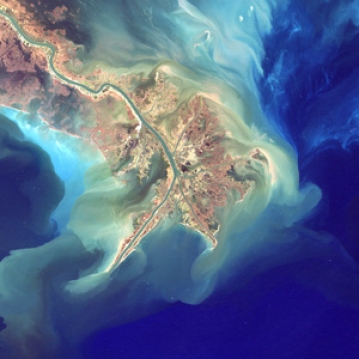
 |
So-called dead zones are areas of large bodies of water—typically in the ocean but also occasionally in lakes and even rivers— that do not have enough oxygen to support marine life. The cause of such “hypoxic” (lacking oxygen) conditions is usually eutrophication, an increase in chemical nutrients in the water, leading to excessive blooms of algae that deplete underwater oxygen levels. Nitrogen and phosphorous from agricultural runoff are the primary culprits, but sewage, vehicular and industrial emissions and even natural factors also play a role in the development of dead zones. Dead zones
occur around the world, but primarily near areas where heavy
agricultural and industrial activity spill nutrients into the water and
compromise its quality accordingly. Some dead zones do occur naturally,
but the prevalence of them since the 1970s – when dead zones were
detected in Chesapeake Bay off Maryland as well as in Scandinavia’s
Kattegat Strait, the mouth of the Baltic Sea, the Black Sea and the
northern Adriatic—hints at mankind’s impact. A 2008 study found more
than 400 dead zones worldwide, including in South America, China, Japan,
southeast Australia and elsewhere. |
Fortunately, dead zones are reversible if their causes are reduced or eliminated. For example, a huge dead zone in the Black Sea largely disappeared in the 1990s following the fall of the Soviet Union, after which there was a huge spike in the cost of chemical fertilizers throughout the region. And while this situation was largely unintentional, the lessons learned have not been lost on scientists, policymakers and the United Nations, which has been pushing to reduce industrial emissions in other areas around the globe where dead zones are a problem. To wit, efforts by countries along the Rhine River to reduce sewage and industrial emissions have reduced nitrogen levels in the North Sea’s dead zone by upwards of 35 percent.
In the U.S., dead zones have also been reduced in the Hudson River and San Francisco Bay following clean-up efforts. Hypoxic conditions continue to plague the Gulf of Mexico, however, with matters made worse by pollution unleashed by Hurricane Katrina and the BP oil spill, as well as by a federal push to increase Midwest corn production, which effectively loads even more algaeinducing nutrients into the already overloaded system. The Mississippi Basin/Gulf of Mexico Water Nutrient Task Force, a coalition of federal, state and tribal agencies, has been busy monitoring the dead zone and recommending ways to reduce it since its formation in 1997. But with industrial and agricultural activity throughout Gulf and Midwestern states only increasing – and Mother Nature not making the job any easier – the task force has an uphill battle on its hands to say the least.
CONTACTS: Mississippi Basin/Gulf of Mexico Water Nutrient Task Force, www.epa.gov/owow_keep/ msbasin. EarthTalk is written and edited by Roddy Scheer and Doug Moss and is a registered trademark of E - The Environmental Magazine (www.emagazine.com). Send questions to: earthtalk@emagazine.com. Subscribe: www.emagazine.com/subscribe. Free Trial Issue: www.emagazine.com/trial.
